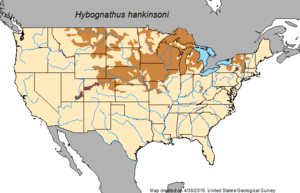Brassy minnow facts for kids
The brassy minnow (Hybognathus hankinsoni) is a small, shiny fish. It belongs to the Cyprinidae family, which includes many freshwater minnows and carps.
Its scientific name, Hybognathus hankinsoni, has a cool meaning. "Hybognathus" comes from a Greek word meaning "bulging jaw." "Hankinsoni" honors T.L. Hankinson, an American scientist. You can find these fish in the northern United States and Canada.
Quick facts for kids Brassy minnow |
|
|---|---|
| Conservation status | |
| Scientific classification |
Contents
What Does a Brassy Minnow Look Like?
Brassy minnows are usually 4 to 7.5 centimeters (about 1.5 to 3 inches) long. They weigh between 0.7 and 4 grams. That's about as much as a few paper clips!
You can spot them by their shiny, brassy-colored sides. Their bellies are creamy, and their backs are olive green. They have a dark stripe that goes from their gill cover all the way to their tail.
Special Features of Brassy Minnows
These fish have scales that are a bit bigger than usual. They also have a small dorsal fin on their back with a rounded tip. Two other fins, called pelvic fins, are located behind the dorsal fin.
Female brassy minnows are often larger than the males. They have a small mouth that points slightly downwards. Their tail fins are notched, like a small "V" shape.
Where Do Brassy Minnows Live?
Brassy minnows live in many places across North America. Their home range stretches from the St. Lawrence River and Lake Champlain areas. You can also find them throughout the Great Lakes region and the northern United States. They even live as far west as Alberta and British Columbia in Canada.
Brassy Minnow Homes
These fish like cool, slow-moving streams and creeks. They prefer places with sandy, muddy, or gravel bottoms. These bottoms often have a layer of organic stuff, like tiny bits of plants.
You might also find them in other watery spots. This includes ponds near rivers that sometimes overflow. They can live in boggy lakes, slightly salty tidal waters, and ditches with lots of weeds.
Surviving in Different Waters
Brassy minnows are tough! They can live in water with many different pH levels. They can even survive when oxygen levels are low. This means they are very good at adapting to their environment.
The water they live in can be clear or turbid (cloudy). However, they do best in places where there aren't many predators. They also like habitats with places to hide, like plants or rocks. This helps them stay safe from bigger fish.
What Do Brassy Minnows Eat?
Brassy minnows are omnivores, meaning they eat both plants and animals. They munch on algae, tiny plankton, and small water bugs. These foods are found in the organic stuff on the bottom or in the weeds.
Even though they are omnivores, they mostly eat plants. Their favorite foods are algae, especially tiny types called diatoms and desmids. They often feed in groups, called schools. They tend to eat the most in the afternoon, around 1 to 3 PM.
Their Role in the Food Web
Brassy minnows are "first-level consumers." This means they eat producers (like algae). They are important because they help move nutrients up the food chain. They provide food for bigger fish and other animals.
Brassy Minnow Life Cycle
Brassy minnows become old enough to have babies when they are one or two years old. They lay their eggs, a process called spawn (biology), from April to July. The exact time depends on where they live. Fish in colder, northern areas spawn later in the year.
Spawning and Eggs
Spawning happens when the water temperature reaches about 16 to 17 degrees Celsius (61-63 degrees Fahrenheit). Female brassy minnows lay their eggs on plants and along the bottom of streams and ponds. A female can lay up to 2,500 eggs! The number of eggs depends on her size. She usually releases all her eggs over about a week.
The eggs hatch in about 7 to 10 days. The baby fish, called larvae, grow very quickly in their first few months. Brassy minnows can live up to 5 years. They lay eggs every year once they are old enough.
Conservation Status
Good news! The brassy minnow species is considered "globally secure." This means there are plenty of them, and they don't have any major conservation worries right now.
See also
 In Spanish: Hybognathus hankinsoni para niños
In Spanish: Hybognathus hankinsoni para niños



